There is a Polish expression: Błogosławiony dom w którym pająki są, which roughly translates to: God blesses the home with a spiderweb in it.
Or something like that.
That expression there is the crux of the pajaki (prounounced Pie-Yonky). Pajakis are a traditional Polish folk art made to look like elaborate spiderwebs. The literal translation is spiders of straw. To you or me they look like paper chandeliers, but to spiders, apparently they look like big glitzy condominium. So, my dining room is like Las Vegas for arachnids. Who knew?

Okay, I know what you are thinking; Spiderwebs at Christmas? Seriously? That’s sort of gross. You want me to put a web in my house for real?
Yes real.
For one thing, The Baby Jesus liked spiders. So there. And, in fact, tinsel is symbolic of the spiderweb that protected Mary and Jesus from Herod in a cave one scary night (read more about this according to The Gospel of Matthew).
And for another thing, Dude, spiders are lucky. And not just at Christmas. And spiderwebs are even luckier. If you find an abandoned spiderweb intact, you are Go-Buy-A-Lotto-Ticket lucky. But— and listen here because this part is important—if you tear, damage, or remove a spiderweb in any way, you will not have good luck. Getting rid of spiderwebs is very bad joojoo. Very bad. I once saw a neighbor woman clean spiderwebs off her garage door and the very next day she was in a car accident. I’m not even kidding. She was fine but the car was wrecked and it all could have been prevented had she just left that spider alone to live in peace in his web. This is why people are scared of them – spiders will take you down to Chinatown if you mess with them.
In conclusion: be nice to spiders. Not just because it’s bad joojoo, but because it’s what Jesus would do.

| Spiders and Christmas trees go together. Believe it! |
If you did not notice, I have strong opinions about all things superstitious. Old, new, whatever. I make them up as I see fit. Don’t pay attention to me. I also think it is unlucky to let the phone ring four times or to open a bag of potato chips with a ragged edge. I can’t sleep without rubbing my feet together for good luck. I have issues. It’s because I’m Polish. Not really. I mean yes, I am part Polish but that’s not why I have issues. Should we start talking about the craft now? Okay. Here we go…

I made this on the fly so exact quantities here are not listed. The good news is that with the exception of the circle base, I didn’t purchase any special items for this project. All in, this pajaki cost me exactly $1 to make. My prababcia would be so proud!
Materials
- 150ish 2” lengths of drinking straws. I used thin red coffee straws, but any plastic or paper straw would work. Traditional pajakis would be assembled using straws taken from the hollow shafts of rye grass.
- 150ish paper circles cut from sturdy paper. I used the scraps of a previous project that used card stock. I also added some circles cut from tissue paper and wax paper, but I used those to double up on the sturdier stuff. You could also skip circles and make geometric shapes or flowers or something fun. In retrospect, circles seem a little boring now.
- 1 lightweight wire circle. I went to the thrift store and bought an 18” paper lampshade for $1, then tore off all the paper. You could use a wreath form, a hula hoop, or maybe something from the garden center. Whatever it is, just make sure it lays in a perfectly flat circle. You could make your own out of a coat hanger or something but if it’s even a teensy bit off, it will throw off the balance of the final piece. So beware the non-symmetrical circle.
- Bias tape, ribbon, or twine. If you use ribbon, make sure it is thin and flexible (satin would work better than grosgrain).
- One thick needle and strong thread. I used dental floss. Upholstery thread would be fine.
- One pipe cleaner.
- Accent flowers. I made mine from coffee filter flowers I had leftover from easter. You could use fiesta flowers made from tissue, or cupcake liners, or just buy some silk flowers at the dollar store. Anything lightweight will work.
Spiders and chains is the name for traditional Polish Christmas garland and is a forerunner to the paper chains we all made in kindergarten. In this case, it provides the basic framework for the pajaki. I am making mine by alternating small circles (spiders) and straws (chains). I made ten lengths or roughly 60” each. If your ceilings are not so tall, you might want to cut that back a bit.
1. After finishing ten lengths of garland, I tied them all to a single pipe cleaner and wrapped it around the bottom of my chandelier. If you don’t have a chandelier hanging around, put a thumbtack at the top of the doorway or something. Do whatever you need to do to get them hanging upright. 2. Wrap the ribbon around the wire circle as tightly as possible. Secure with a dab of glue or knot in place accordingly. 3. Cut ribbons into 3” lengths and tie one to each garland in the same spot.
Moving one at a time, tie the 3” lengths of ribbon around the hoop. Skip from side to side with each knot. If you can imagine the wire circle was the face of a clock, start at 12, then skip to 6, then 3, then 9, then 1, and so on…. Does that make sense? I hope so.
The base is done! Now it’s time to embellish with flowers. I cut my flowers from pre-dyed coffee filters left over from other projects, plus a couple of cupcake liners stapled together (see here for more). You could use tissue paper or wrapping paper, or whatever you want. You could even go to the dollar store and buy a bunch of fake flowers. Your call, just make sure they are lightweight.
This Christmas, I hung my pajaki around an existing pendant light in my dining room by wrapping the pipe cleaner around point where the hanging wire meets the ceiling cap. It held just fine but I covered it with a thin strip of duct tape just be sure. If this were going to hang for more than a few weeks I would probably figure a way to cover the bare bulb, but for now I’m OK with it. Maybe next year I’ll come up with a better plan. For now, it’s a lovely mobile.
It’s strange how something can look like Christmas and sunflowers at the same time.
Wesołych Świąt Bożego Narodzenia i Szczęśliwego Nowego Roku!
(Merry Christmas)
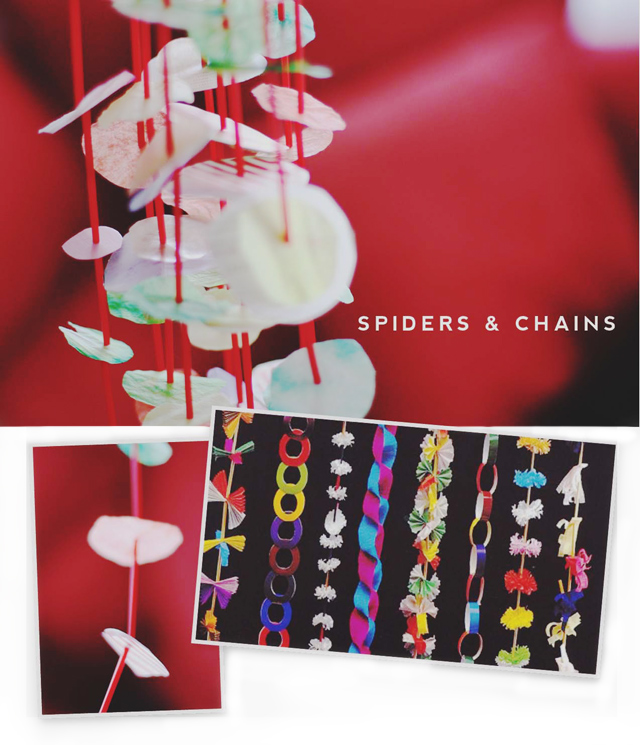
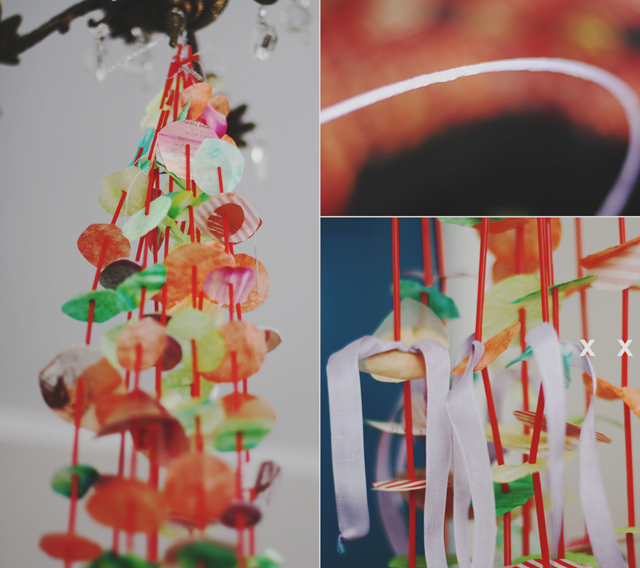
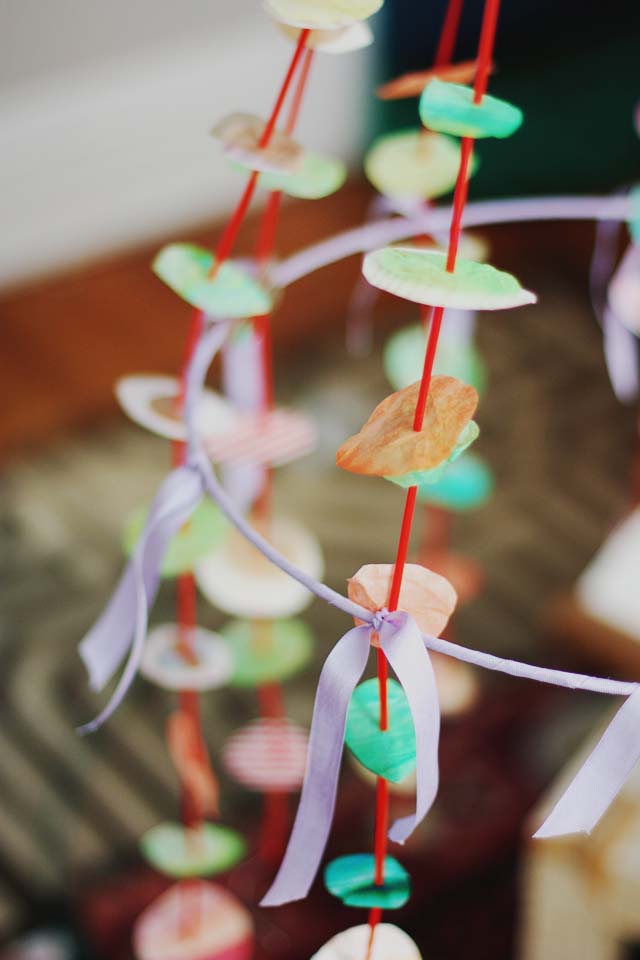
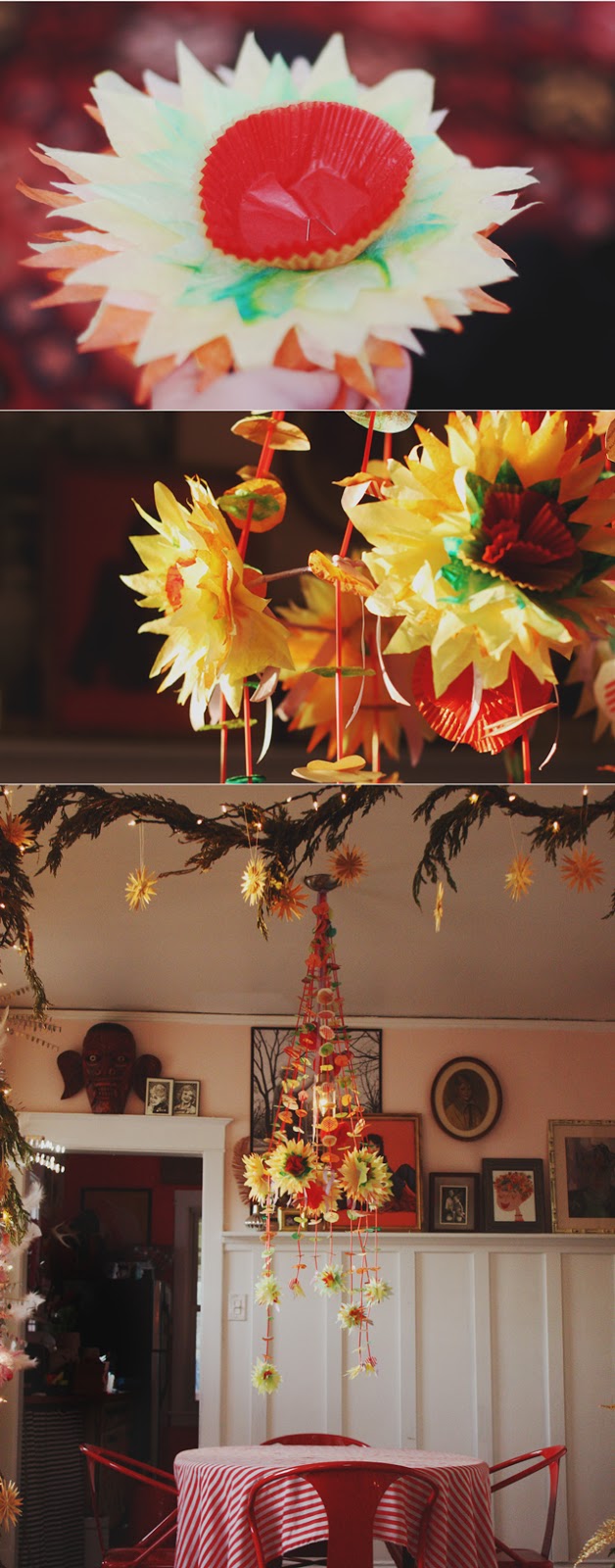

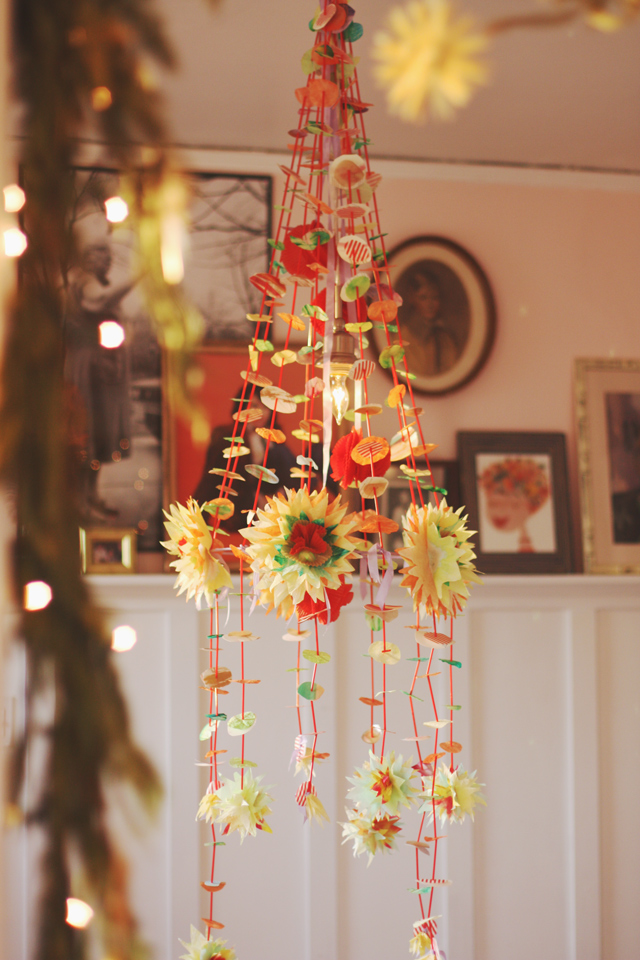
Great job! Awesome really! I’m polish like 1000% straight from the boat polish and I was happy to see you write in polish! You are awesome.
I remember, that you shouldn’t kill spider because storm will be. Szczęśliwy dom gdzie pająki są – Happy home where spiders are. If you clean up less you have more time for family 🙂
Correct. That is why the link is credited to The Gospel of Matthew, by William Barclay, a respected author whose works are considered standard textbooks in many theological seminaries. The passage in discussion refers to the BIble passage Matthew 2:13 – 15, the tale of the spider is a well-known and beloved children’s story.
Thanks!
That link you have isn’t even the real Bible… The Bible never says anything like that.
Eeek. I’ve killed so many spiders and ruined so many webs in my life, it’s no wonder I have bad luck! Maybe I should make one of these to even things out!
Oh yay! pajaki time! everything looks great as usual, Peaches!
You’ve alluding to the coming of this project, and the result is awesome. It looks much more like an artifact than a craft project. (Does that make sense? I worry about things sounding insulting when I mean them well.) BTW – I tried going to the Christkindlmarket last weekend; wowser, too crowded for me. I might try again on a weekday.
“Błogosławiony dom w którym
pająki są” = God blesses the home with a spider
in it. It’s very old and it’s says something like: if the spider chooses your house it’s mean your home is full of happiness and hospitality. And these ‘pajaki’ comes from Polish folk culture. It was the way to spend time and decorate houses. The ladies always made new ones in Christmas time to decorate houses. It’s nice that you made your own. They are realy pretty. Kind regards and Marry Christmas.
Who knew spider webs could be so cute 🙂
Your pajaki is so pretty and festive Aunt Peaches! And we love that you respect the spiders. We don’t know the children’s story, but we do know that Spiderwoman weaved the web of the world (Dine’) and Iktomi (Lakohta) will take you down to Chinatown if you tick him off!
Oom pah pah!!! Polka time ’round the pajaki. This is the year I’m going to make my own!! Thanks for the push.
Very nice! Is there a traditional color scheme, or are they usually straw colored? So you are part Polish, part Austrian, part Southern, and part Auntie Mame? I really like your paneling in the dining room. Where are all the landscapes? In another room? Did you know that most Victorian crazy quilts should have a spider web embroidered on them?
I just made an easter ‘pajaki’ post, and had to link to your tutorial here, beecause it is so funny – and also I think your pajaki is really quite something, having googled the topic extensively, and seen many of them. I like that it is a bit organic and ad hoc – and your flowers are really beautiful. I have yet to make one myself, but you inspired me enormously. Happy easter!
That is stunning! Absolutely incredible, but your instructions make it sound so simple! I am dying to give this a shot!